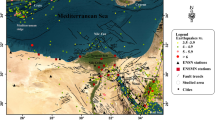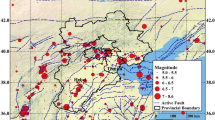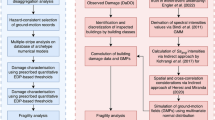Abstract
Located at the North-Eastern part of Algeria (Tellian Atlas), Constantine has crucial administrative, economic, scientific and cultural importance. It has continuously experienced significant urban evolutions during the different periods of its history. The city is located in an active seismic region within Algeria and has been struck in the past by several moderate and strong earthquakes. The strongest earthquake recorded since the beginning of instrumental seismology took place on October 27, 1985 with a magnitude M\(_\mathrm{S}=\) 5.9. Constantine presents a high seismic risk, because of its dense housing and high population density (2,374 inhabitants/km\(^{2})\). This requires a risk assessment in order to take preventive measures and reduce the losses in case of potential major earthquake. For this purpose, a scenario based approach is considered. The building damage assessment methodology adopted for the Algerian context is adapted from HAZUS approach. In the present case, the effective Algerian seismic code response spectrum (RPA 99/2003) is considered as a seismic hazard model. The prediction of the expected damages is performed for a set of almost 29,000 buildings.














Similar content being viewed by others
References
Ambraseys NN, Douglas J, Sarma SK, Smith PM (2005) Equations for the estimation of strong ground motions from shallow crustal earthquakes using data from Europe and the Middle East: horizontal peak ground acceleration and spectral acceleration. Bull Earthq Eng 3:1–53. doi:10.1007/s10518-005-0183-0
Ambraseys NN (1995) The prediction of earthquake peak ground motion in Europe. Earthq Eng Struct Dyn 24:467–490
Ambraseys NN, Bommer JJ (1991) The attenuation of ground accelerations in Europe. Earthq Eng Struct Dyn 20(12):1179–1202
Athanasopoulos GA, Pelekis PC, Leonidou EA (1999) Effects of surface topography on seismic ground response in the Egion (Greece) 15 June 1995 earthquake. Soil Dyn Earthq Eng 18:135–149
Applied Technology Council (1996) ATC-40: seismic evaluation and retrofit of concrete buildings, vol 1. Redwood City, CA, USA
Ayadi A, Ousadou-Ayadi F, Bourouis S, Benhallou H (2002) Seismotectonics and seismic quietness of the Oranie region (Western Algeria): the Mascara earthquake of August 18\({th}\) 1994, M\(_{w}\) = 5.7, M\(_{s}\) = 6.0. J Seismol 6:13–23
Belabbès S, Meghraoui M, Çakir Z, Bouhadad Y (2009) InSAR analysis of a blind thrust rupture and related active folding: the 1999 Ain Temouchent earthquake (\(M\)w 5.7, Algeria) case study. J Seismol 13:421–432
Belazougui M (2008) Boumerdès Algeria earthquake of May 21, 2003: damage analysis and behavior of beam-column reinforced concrete structures. In: Proceedings of the 14\({th }\) world conference on earthquake engineering, Bei**g, China, Paper 14\_01-1006
Benaissa A, Bellouche MA (1999) Geotechnical properties of some landslide-prone geological formations in the urban area of Constantine (Algeria). Bull Eng Geol Env 57:301–310
Benaissa A, Cordary D, Giraud A (1989) Ground motions in the urban area of Constantine (Algeria). Bull Int Assoc Eng Geol 40:85–90
Benouar D (1994) Materials for the investigation of The seismicity of Algeria and Adjacent Regions During the Twentieth Century. Ann Geofis 37:402
Bertero V, Shah H (1983) El-Asnam, Algeria Earthquake of October 10, 1980. A reconnaissance and engineering report, Report EERI, January 1983
Bezzeghoud M, Buforn E (1996) Study of the Athusemas (26/05/94) and Mascara (18/08/94) earthquakes and seismotectonics of the region. Ann Geoph, EGS, The Hague, 6–10 May 1996. Part I, 14, p 88
Boughacha MS, Ouyed M, Ayadi A, Benhallou H (2004) Seismicity and seismic hazard map** of northern Algeria: map of Maximum Calculated Intensities (MCI). J Seismol 8:1–10
Bouhadad Y (2009) Probabilistic seismic hazard assessment in eastern Algeria. In: Proceedings of the Workshop Seismicity patterns in the Euro-Med region, Luxembourg pp 89–94
Bouhadad Y, Nour A, Laouami N, Belhai D (2003) The Beni-Ourtilane-Tachaouaft fault and Seismotectonic aspects of the Babors region (NE of Algeria). J Seismol 7:79–88
Boukri M, Farsi MN, Mébarki A, Belazougui M (2013) Development of an integrated approach for Algerian building seismic damage assessment. Struct Eng Mech 47(4):471–493. doi:10.12989/sem.2013.47.4.471
Boukri M, Bensaïbi M (2008) Vulnerability index of Algiers masonry buildings. In: Proceedings of the 14th world conference on earthquake engineering, Bei**g, China, paper 14\_09-01-0118
Bounif A, Bezzeghoud M, Dorbath L, Legrand D, Deschamps A, Rivera L, Benhallou H (2003) Seismic source study of the 1989, October 29, Chenoua (Algeria) earthquake from aftershocks, broad-band and strong ground motion records. Ann Geophys 46(4):625–646
Bounif A, Haessler H, Meghraoui M (1987) The Constantine (northeast Algeria) earthquake of October 27, 1985: surface ruptures and aftershock study. Earth Planet Sci Lett 85:451–460
Bourdeau C, Havenith HB (2008) Site effects modelling applied to the slope affected by the Suusamyr earthquake (Kyrgyzstan, 1992). Eng Geol 97:126–145
Boussouf R (2002) Constantine: D’une ville attractive à une ville répulsive, Laboratoire d’aménagement du territoire, Université de Constantine, Algérie. (in French)
CGS (2011a) Seismic Microzoning Study of Urban Areas in Constantine City. Report, National Earthquake Engineering Research Center, CGS
CGS (2011b) Seismic Hazard Study of Urban Areas in Constantine City. Report, National Earthquake Engineering Research Center, CGS
CGS (1998) Probabilistic hazard assessment of the Algiers region. Report, National Earthquake Engineering Research Center, CGS
Chopra AK, Goël RK (1999) Capacity demand diagram methods based on inelastic design spectrum. Earthq Spectra 15(4):637–656
Comartin C, Niewiarowski R, Freeman SA, Turner F (2000) Seismic evaluation and retrofit of concrete buildings: a practical overview of the ATC 40 Document. Earthq Spectra 16:1–310
CTC (1981) Genaral report on Ech-Cheliff (El Asnam) earthquake of October 10th, 1980, Construction Technical Control, Algeria
Deschamps A, Bezzeghoud M, Bounif MA (1991) Seismological study of the Constantine (Algeria) earthquake (27 October 1985). In: Mezcua J, Udías A (eds), Seismicity and seismic risk of the Ibero-Maghrebian region, I.G.N Publication 8, pp 163–173
Fajfar P (1999) Capacity spectrum methods based on inelastic demand spectra. earthq Eng Struct Dyn 28:979–993
Farsi MN, Belazougui M (1992) The Mont Chenoua (Algeria) Earthquake of October 29th 1989; Damage assessement and Distribution. In: Proceedings of the 10th world conference on earthquake engineering, Madrid, Spain
Federal Emergency Management Agency (2002) HAZUS99: earthquake loss estimation methodology, Technical manual. Washington, DC, USA
Guemache MA, Chatelain JL, Machane J, Benahmed S, Djadia L (2011) Failure of landslide stabilization measures: The Sidi Rached viaduct case (Constantine. Algeria). J Afr Earth Sci
Hamdache M, Peláez JA, Talbi A, López Casado C (2010) A Unified Catalog of Main Earthquakes for Northern Algeria from A.D. 856 to 2008. Seismol Res Lett 81(5):732–739
Harbi A, Peresan A, Panza GF (2010) Seismicity of Eastern Algeria: a revised and extended earthquake catalogue. Nat Hazards 54:725–747
Jerez S, Mébarki A (2011) Seismic assessment of framed buildings: a pseudo-adaptive uncoupled modal response analysis. J Earthq Eng 15(7):1015–1035 World Scientific Publishing Co.
Joyner WB, Boore DM (1981) Peak horizontal acceleration and velocity from strong-motion records including records from the 1979 Imperial Valley, California, earthquake. Bull Seism Soc Am 71:2011–2038
Machane D, Bouhadad Y, Cheikhlounis G, Chatelain JL, Oubaiche EH, Abbes K, Guillier B, Bensalem R (2008) Examples of geomorphologic and geological hazards in Algeria. Nat Hazards. doi:10.1007/s11069-007-9167-5
Mahaney JA, Terrence FP, Bryan EK, Sigmund AF (1993) The Capacity Spectrum Method for Evaluating Structural Response during the Loma Prieta Earthquake. In: Proceedings of the 1993 United States national earthquake conference. Memphis, Tennessee vol 2, pp 501–510
Mébarki A, Boukri M, Laribi A, Farsi MN, Belazougui M, Kharchi F (2013) Seismic vulnerability: theory and application to Algerian buildings. J Seismol. doi:10.1007/s10950-013-9377-0
Mébarki A (2009) A comparative study of different PGA attenuation and error models: case of 1999 Chi-Chi earthquake. Tectonophysics 466(3–4):300–306
Meslem A, Yamazaki F, Maruyama Y, Benouar D, Kibboua A, Mehani Y (2012) The effects of building characteristics and site conditions on the damage distribution in Boumerdès after the 2003 Algeria Earthquake. Earthq Spectra 28(1):185–216
Micosoft Encarta Encyclopedia (2007) Microsoft Corporation. United States, 1993–2007
RPA99/2003, Algerian Seismic Code (2004) Ministry of Housing and Urban Planning, Algeria
NOS: National Office of Statistics (2008) General Census of Population and Housing, Algeria
Ousadou F, Dorbath L, Dorbath C, Bounif MA, Benhallou H (2013) The Constantine (Algeria) seismic sequence of 27 October 1985: a new rupture model from aftershock relocation, focal mechanisms, and stress tensors. J Seismol 17(2):207–222
Pagliaroli A, Lanzo G, D’Elia B (2011) Numerical evaluation of topographic effects at the Nicastro ridge in Southern Italy. J Earthq Eng 15(3):404–432
Sadigh K, Chang CY, Abrahamson NA, Chiou SJ, Power MS (1993) Specification of long-period ground motions: Updated attenuation relationships for rock site conditions and adjustment factors for near-fault effects. Pages 59–70 of: proceedings of ATC-17-1 seminar on seismic isolation, passive energy dissipation, and active control
Sepulveda SA, Murphy W, Jibson RW, Petley DN (2005) Seismically induced rock slope failures resulting from topographic amplification of strong ground motions: the case of Pacoima Canyon, California. Eng Geol 80:336–348
Shafique M, Van der Meijde M, Kerle N, Van der Meer F (2011) Impact of DEM source and resolution on topographic seismic amplification. Int J Appl Earth Obs 13:420–427
Veludo I, Teves-Costa P, Bard PY (2013) Damage seismic scenarios for Angra do Heroismo, Azores (Portugal). Bull Earthq Eng 11:423–453
Vila JM (1980) La chaîne alpine d’Algérie orientale et des confins algéro-tunisiens, PhD thesis, University of Paris VI, pp 665 (in French)
Wells DL, Coppersmith KJ (1994) New empirical relationships among magnitude, rupture length, rupture width, rupture area, and surface displacement. Bull Seismol Soc Am 84(4):974–1002
Yelles-Chaouche AK, Djellit H, Beldjoudi H, Bezzeghoud M, Buforn E (2004) The Ain Temouchent (Algeria) Earthquake of December 22nd, 1999. Pure Appl Geophys 161:607–621
Yelles-Chaouche AK., Djellit H, Derder MEM, Abtout A, Bourouis S (1997) The Ain Benian fault: a new active coastal fault revealed by the Algiers September 4 1996 earthquake, IASPE, Thessaloniki, Greece, 18–28 August 1997
Acknowledgments
An important part of the building inventory of Constantine city and data collection was carried out by the engineers as staff of the CGS office at Constantine; the authors are grateful to Boukal, I., Souki, E., Bouaoud, M., and Fettar, B. Final redaction and discussions have also benefited from the CMEP Tassili project (11 MDU 847: 2011–2014).
Author information
Authors and Affiliations
Corresponding author
Appendix: Methodology for assessment of building damages expected from seismic effects
Appendix: Methodology for assessment of building damages expected from seismic effects
The global procedure adopted to estimate the expected damages under seismic effects (earthquake scenario) for Constantine city buildings is adapted from HAZUS (Hazard United-States) approach (The FEMA Tool Estimating Earthquake Losses) (FEMA 2002). Based on the capacity spectrum method, it is adopted worldwide (Mahaney et al. 1993; ATC-40 1996; Comartin et al. 2000; Chopra and Goël 1999; Fajfar 1999). The adaptation to the Algerian case relies mainly on the specificity of Algerian soils and their dynamic properties (local and site effects: seismic input) as well as the specific material properties and the structural types that govern the structural dynamic response (seismic output). According to the intersecting performance point between the seismic load (elastic response spectrum) and the structural response (capacity curve), the corresponding spectral displacement identifies and indicates the level of structural damage, as shown in Fig. 15. Actually, this spectral displacement provides the probability of damage level occurrence on the fragility curve adopted for the concerned structural type. Therefore, the probabilities of damage and their category levels are obtained for the considered structure under the given seismic input.
Seismic damage estimation procedure (Boukri et al. 2013)
General flowchart: seismic damage evaluation procedure (Boukri et al. 2013)
Figure 16 shows the flowchart used to evaluate the damage probabilities. This flowchart consists in seven (07) main steps which are:
-
Step 1 Choice of the building type according to the height and the corresponding seismic code level.
-
Step 2 Development of the elastic response spectrum (\(\xi = 5\,\%\): dam**) adapted to the concerned site, and transformed into the format “Acceleration-Displacement Response Spectrum” (ADRS) using the following relationship:
where: \(T\) [unit: s] represents the Period of the building; \(S_{ dy}\)[unit: m] and \(S_{ay }\)[unit: m s \(^{-2}\)] represent the spectral displacement and the spectral acceleration, respectively.
-
Step 3 Generation of the capacity curve
The capacity curve relates the resulting shear effort acting at the building base to the top total displacement of the building. The push-over response depends on the geometry, the constitutive materials behaviour considered as linear or nonlinear with possible P-Delta effects, (Jerez and Mébarki 2011). This curve is transformed into ADRS format in order to be compared to the elastic response spectrum (Fig. 3). The main parameters of this capacity curve are:
-
(1)
Yield capacity point (\(D_{y}, A_{y}\))
-
(2)
Ultimate capacity point (\(D_{u}, A_{u}\))
\(D\) and \(A\) express the displacement and acceleration point of the capacity curve, respectively
-
Step 4 Definition of the performance point
The performance point (\(S_{d})\) represents the performance of the building or generic classes of buildings under the effect of a given seismic action level. It expresses the interaction between the capacity curve of the building and the elastic response spectrum for the considered soils conditions (FEMA 2002; ATC-40 1996). Once defined, this point provides the probability of damages occurrence by using fragility curves.
-
Step 5 Generation of damage functions
The damage curves are commonly adopted as being lognormal fragility curves that express the probability \(P[d_{s}{\vert }S_{d}]\) of reaching or exceeding a given level of structural or non-structural damage (\(d_{s})\), for a spectral displacement (\(S_{d})\) at the performance point. The cumulative distribution for a given damage level (d\(_{s})\) gives therefore the probabilities for each category of damage \(P[N{\vert }S_{d}]\), \(P[S{\vert }S_{d}]\), \(P[M{\vert }S_{d}]\), \(P[E{\vert }S_{d}]\), \(P[C{\vert }S_{d}]\) as expressed by Eq. 5 (Federal Emergency Management 2002):
where, \(S_{d}\) is the spectral displacement (acting as seismic demand and input); \(S_{d,ds }\)represents the mean value of the spectral displacement for a given damage level taken equal to “\(d_{s}\)”; \(\beta _{ds }\)is the logarithm value of the displacement standard deviation “\(d'' \)for the damage level or category \(d_{s}; \Phi \)(.) is the cumulative standardized Gaussian distribution function; \(P[S{\vert }S_{d}]\) represents the occurrence probability of a slight damage “S”; \(P[M{\vert }S_{d}]\) is the occurrence probability of a moderate damage “M”; \(P[E{\vert }S_{d}]\) is the occurrence probability of an important and extended damage “E” and \(P[C{\vert }S_{d}]\) is the occurrence probability of a complete damage “C”.
-
Step 6 Calculation of the specific damage category probabilities
The specific damage category probability, corresponding to each category or level of damage, is then derived from the cumulative probabilities as follows:
-
Step 7 Generation of the Damage probability matrix for the considered type (see Table 10).
Rights and permissions
About this article
Cite this article
Boukri, M., Farsi, M.N., Mebarki, A. et al. Seismic risk and damage prediction: case of the buildings in Constantine city (Algeria). Bull Earthquake Eng 12, 2683–2704 (2014). https://doi.org/10.1007/s10518-014-9594-0
Received:
Accepted:
Published:
Issue Date:
DOI: https://doi.org/10.1007/s10518-014-9594-0






